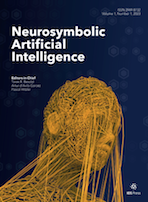Neurosymbolic Artificial Intelligence Peer Review Policy
Neurosymbolic Artificial Intelligence relies on an open and transparent peer review process. Papers submitted to the journal are quickly pre-screened by the Editors-in-Chief and if deemed suitable for formal review they are immediately published as pre-prints on the journal’s website. Please visit our reviewer guidelines for further information about how to conduct a review.
Reasons to reject a paper in the pre-screening process could be because the work does not fall within the aims and scope, the writing is of poor quality, the instructions to authors were not followed or the presented work is not novel.
Papers that are suitable for review are posted on the journal's website and are publicly available. In addition to reviews solicited by members of the editorial board, public reviews and comments are welcome by any researcher and can be uploaded using the journal website. All reviews and responses from the authors are posted on the website as well.
Reviewers are by default identified by name although all reviewers do have the option to remain anonymous. All review reports are made openly available under CC-BY licenses after a decision has been made for the submission (independent of whether the decision was accept or reject). In addition to solicited reviews, any researcher is welcome to submit additional reviews and comments for papers that are under review. Editors and non-anonymous reviewers will be mentioned in the published articles.
Each paper that undergoes peer review is assigned a handling editor who will be responsible for inviting reviewers to comment on the paper.
The reviewer of a paper is asked to submit one of the following overall recommendations:
- Accept. The article is accepted as is, or only minor problems must be addressed by the authors that do not require another round of reviewing but can be verified by the editorial and publication team.
- Minor revisions required. The authors are required to make moderate changes to their manuscript. The manuscript becomes acceptable for publication if the changes proposed by the reviewers and editors are successfully addressed. The revised manuscript will be examined by the Editors-in-Chief and possibly sent back to all (or a selection of) reviewers for a second round of reviews. Authors are requested to provide a letter to the reviewers detailing the improvements made for the resubmission.
- Major revisions required. The manuscript cannot be accepted for publication in its current form. However, a major revision which addresses all issues raised by the reviewers may be acceptable for publication. The revised manuscript will undergo a full second round of review. Authors are requested to provide a letter to the reviewers detailing the improvements made for the resubmission.
- Reject. The work cannot be published based on the lack of interest, lack of novelty, insufficient conceptual advance or major technical and/or interpretational problems.
Finally, reviewers are asked to answer the following points:
- Summary of paper in a few sentences
- Reasons to accept
- Reasons to reject
- Further comments (optional)
Accept or reject decisions are made by the Editors-in-Chief, whose decision is final.
Reviewers are requested to evaluate regular research articles with respect to the following criteria:
- Significance. Does the work address an important problem within the research fields covered by the journal?
- Background. Is the work appropriately based on and connected to the relevant related work?
- Novelty. For research papers: Does the work provide new insights or new methods of a substantial kind? For survey papers: Is the topic covered in a comprehensive and well balanced manner, are the covered approaches accurately described and compared, and are they placed in a convincing common framework?
- Technical quality. For research papers: Are the methods adequate for the addressed problem, are they correctly and thoroughly applied, and are their results interpreted in a sound manner? Are the experiments replicable and has all relevant data for replication be made available? For survey papers: Is the topic covered in a comprehensive and well balanced manner, are the covered approaches accurately described and compared, and are they placed in a convincing common framework?
- Presentation. Are the text, figures, and tables of the work accessible, pleasant to read, clearly structured, and free of major errors in grammar or style?
- Length. Is the length of the manuscript appropriate for what it presents?
- Data availability. Are all used and produced data openly available in established data repositories, as mandated by FAIR data and the data availability guidelines?
Review criteria for survey articles:
Survey articles are full-length papers surveying the state of the art of topics central to the journal's scope. Authors may want to contact the editors before writing a survey. Survey articles should have the potential to become well-known, highest quality introductory and overview texts. These submissions will be reviewed along the following dimensions: (1) Suitability as introductory text, targeted at researchers, PhD students, or practitioners, to get started on the covered topic. (2) How comprehensive and how balanced is the presentation and coverage. (3) Readability and clarity of the presentation. (4) Importance of the covered material to the broader Neurosymbolic AI community.
Submitting Reviews
To submit a solicited review, please do so by logging in with the account for which the review has been solicited. Then follow the "Reviewer Actions" menu. To submit an open review, please login on this site and post the review as a comment to the manuscript page. Note that all reviews will be screened for appropriate language before being made available publicly.
Protections for non-anonymous reviewers
Please note that authors are not allowed to contact you directly about their paper which you have reviewed. If you get contacted, please notify the editors-in-chief. You should also not contact the authors directly before checking with the editors-in-chief.
